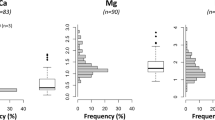Summary
Concentrations of Cu, Fe, Mn, and Zn were measured in bulk atmospheric precipitation, throughfall, stemflow, and soil solutions at 10−, 15−, 25−, and 30-cm depths, in aEucalyptus globulus forest in the Berkeley hills, California, during the 1974–75 wet season after each main storm event. Litter and plant samples were analyzed. There was some similarity in the behavior of Cu, Fe, and Zn, but Mn behaved differently. Mn and Zn are largely deposited on the forest canopy by impaction during dry-deposition episodes, whereas most of the Cu and Fe input occurs in rain. For the hydrologic components measured, concentrations of Cu and Fe increase in the order: precipitation<throughfall<stemflow <soil solutions. For Zn the order is: precipitation<stemflow<throughfall<soil solutions. Concentrations of Cu, Zn, and Fe in the soil solution fluctuate with downward movement of wetting fronts and are negatively correlated with pH. Concentrations of Fe in soil solution are about 10 times greater than those of throughfall and stemflow; the corresponding relative differences for Cu and Zn were much less. Plant uptake of Mn exceeds that of Cu, Zn, and Fe. The increases in Mn concentrations from precipitation to throughfall and stemflow are much greater than those for Cu, Zn, and Fe because precipitation has very low Mn concentrations. The concentration series for Mn is: precipitation<soil solutions<throughfall<stemflow. Concentrations of Mn in the soil solution are negatively correlated with pH. During the dry summer Mn accumulates in the soil, but is quickly flushed by early rains of the wet season.
Similar content being viewed by others
References
Andren, A. W. and Lindberg, S. E. 1977 Atmospheric input and origin of selected elements in Walker Branch watershed, Oak Ridge, Tennessee. Water Air Soil Pollut.8, 199–215.
Andren, A. W., Lindberg, S. E. and Bate, L. C. 1975 Atmospheric input and geochemical cycling of selected trace elements in Walker Branch watershed. Environ. Sci. Div. Publ.728, Oak Ridge Nat. Lab., Tenn. 68 p.
Dixon, W. J. (Ed.) 1967 Biomedical computer programs. 2nd edition. Univ. of California, Berkeley, 600 p.
Grover, B. L. and Lamborn, R. E. 1970 Preparation of porous ceramic cups to be used for extraction of water having low solute concentrations. Soil Sci. Soc. Am. Proc.34, 706–708.
Hansen, E. A. and Harris, A. R. 1975 Validity of soil-water samples collected with porous ceramic cups. Soil Sci. Soc. Am. Proc.39, 528–536.
Heinrichs, H. and Mayer, R. 1977 Distribution and cycling of major trace elements in two central European forest ecosystems. J. Environ. Qual.6, 402–407.
Henriksen, A. and Wright, R. F. 1978 Concentrations of heavy metals in small Norwegian lakes. Water Res.12, 101–112.
Jenne, E. A. 1968 Controls on Mn, Fe, Co, Ni, Cu, and Zn concentrations in soils and water: the significant role of hydrous Mn and Fe oxides.In Trace Inorganics in Water. Ed. R. A. Baker Ad. Chem. Ser.73, Am. Chem. Soc., Washington, D.C., pp 337–387.
Leeper, G. W. 1970 Six trace elements in soils. Melbourne Univ. Press, Melbourne, 59 p.
Lindberg, S. E., Harriss, R. L., Turner, R. R., Shriner, D. S. and Huff, D. L. 1979 Mechanisms and rates of atmospheric deposition of selected trace elements and sulfate to a deciduous forest watershed. Environ. Sci. Div. Publ.1299, Oak Ridge Nat. Lab. Tenn. 514 p.
McColl, J. G. 1977 Retention of soil water following forest cutting. Soil Sci. Soc. Am. J.41, 984–988.
McColl, J. G. 1978 Ionic composition of forest soil solutions and effects of clearcutting. Soil Sci. Soc. Am. J.42, 358–363.
McColl, J. G. 1980 A survey of acid precipitation in northern California. Final report to California Air Resources Board. Univ. California, Berkeley, 94p.
McColl, J. G. and Bush, D. S. 1978 Precipitation and throughfall chemistry in the San Francisco Bay Area. J. Environ. Qual.7, 352–357.
Parker, G. R., McFee, W. W. and Kelly, J. M. 1978 Metal distribution in forested ecosystems in urban and rural Indiana. J. Environ. Qual.7, 337–342.
Reiners, W. A., Marks, R. H. and Vitousek, P. M. 1975 Heavy metals in subalpine and alpine soils in New Hampshire. Oikos26, 264–275.
Semb, A. 1978 Deposition of trace elements from the atmosphere in Norway. SNSF project, Res. Rep.13/78, Norway 28 p.
Stone, E. L. 1968 Microelement nutrition of forest trees: a review.In Forest Fertilization: Theory and Practice. Tennessee Valley Authority, Muscle Shoals, Alabama, pp 132–175.
USDA 1974 Soil survey of Contra Costa County, California (an interium, unedited report). Soil Conservation Service, USDA and Univ. Calif. Agric. Exp. Stn. 488 p.
Author information
Authors and Affiliations
Rights and permissions
About this article
Cite this article
McColl, J.G. Trace elements in the hydrologic cycle of a forest ecosystem. Plant Soil 62, 337–349 (1981). https://doi.org/10.1007/BF02374132
Received:
Revised:
Published:
Issue Date:
DOI: https://doi.org/10.1007/BF02374132




